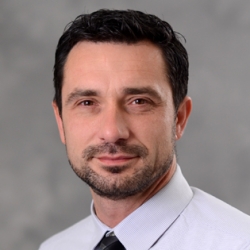Sep 29

Extranodal NK/T-Cell Lymphoma, Nasal or Nasal Type
Posted by Dr. Andrei Shustov
Extranodal NK/T-Cell Lymphoma, Nasal or Nasal Type
Extranodal NK/T-cell Lymphoma (ENNK/TCL) is a unique tumor with an increased incidence in Asia (including China, Korea and Japan). It is a rare subtype of non-Hodgkin lymphoma in North America and Europe. Most of those who are diagnosed and treated in the United States are immigrants or descendants of those who emigrated from an Asian subcontinent. Researchers also suspect that there might be an increased incidence of this cancer in West Coast and Alaskan Native Americans. However, ENNK/TCL can affect people of other ethnic groups.
It is well recognized that this lymphoma is associated with the Epstein-Barr virus (EBV), the same virus that causes mononucleosis in young adults. In fact, testing of this virus in tumor cells is necessary to make a correct diagnosis. Typically, virus is also present in the blood of affected patients. On the other hand, failure to find EBV in the tumor cells makes this diagnosis questionable. Unfortunately, treating the viral infection alone does not cure the lymphoma.
ENNK/TCL can be of two varieties: nasal or nasal type (“nasal” from nose). The name is derived from the unique clinical presentation of this lymphoma – in the nasal cavity, sinuses (like in “sinus headaches”), or the back of the throat or larynx (voice box). In some patients very similar tumors (when assessed under microscope) can be found in other organs, in this case, it would be called nasal type. Patients with lymphoma found only in the nasal (nose) area are thought to have early stage disease, and most of those whose lymphoma is found in other organs are considered to have advanced stage disease.
Patients with nasal (nose area only) ENNK/TCL usually present with long lasting discharge from the nose (that can be bloody), sinus pains, sinus headaches, visual changes, pain in hard palate, foul smelling breath, and facial swelling. These symptoms can be associated with unexplained fevers, nighttime sweats, lack of appetite, and weight loss. If these symptoms persist for more than 2-4 weeks (the usual course of sinus infection), and furthermore, do not respond to treatment with antibiotics – evaluation by an ENT (ear, nose and throat) specialist is recommended. During the evaluation, a biopsy is typically taken from the suspicious areas. In many cases, repeated evaluations are needed with additional biopsies to make a correct diagnosis.
Patients with nasal type (outside nose area) ENNK/TCL may experience a very broad spectrum of symptoms depending on the location of the tumor. Constitutional symptoms (systemic) are frequently present, such as fevers, nighttime sweats and weight loss.
Proper diagnosis and possibly a referral to an outside consultation with lymphoma experts are very important because the treatment of this lymphoma is very unique and different from any other type of non-Hodgkin lymphoma (as described below). It is also very important to find out if the lymphoma spread outside the nasal (nose) cavity in patients with the nasal variant; doctors call it staging, and it is typically done by CT-PET scan and bone marrow biopsy.
The mainstay of treatment of the localized stage ENNK/TCL (confined to nasal cavity) is radiation. This is done by specialized doctors – radiation oncologists. They use X-Ray like beams to treat cancers. Multiple studies in the recent years demonstrated that this lymphoma is more susceptible to radiation than chemotherapy. Patients should never receive the “usual” lymphoma treatment like CHOP. The same mentioned studies also suggested that if one combines radiation with chemotherapy at the same time, the outcomes of treatment might be better. Therefore, younger patients should consider this “combined modality approach”. Doses of radiation used to cure this lymphoma should be higher than those used for other lymphomas. Occasionally, patients will require placement of a temporary feeding tube in the stomach due to the effects of radiation on the throat and difficulties eating and drinking. These effects are transient and go away after the completion of treatment. The whole course of treatment might require 4-5 weeks of continuous radiation given in daily sessions and 3-4 cycles of concurrent chemotherapy given every three weeks; after such treatment, a significant proportion of patients can expect to be cured from their lymphoma.
The treatment of advanced stage ENNK/TCL (spread outside the nose cavity) generally requires multiple (4-6) repeated cycles of multiple-agent chemotherapy. Cycles are given every 3-4 weeks and typically are done in the hospital setting. Once again, traditional CHOP therapy should not be used to treat this lymphoma due to limited efficacy. The recently developed SMILE regimen appears to be very effective with the majority of treated patients achieving complete remission. It is an aggressive regimen, so the support of family/friends is extremely important for patients undergoing this treatment. Older and debilitated patients can be treated with a “lighter” version of SMILE with better tolerance, but still very good efficacy. After completion of treatment, patients should consider consolidative treatment with bone marrow transplantation. This should be discussed with a consulting physician earlier in the treatment course (at the beginning or after 1-2 cycles) such that after completion of chemotherapy you are ready to proceed with transplantation.
Lymphoma that returns after initial treatment (relapsed), or did not respond to initial treatment (refractory) can still potentially be curable. This requires individualized treatment approaches, preferably at specialized academic centers that have established lymphoma/bone marrow transplantation programs.
At any time during the treatment of rare lymphomas, like ENNK/TCL (at the time of first diagnosis or relapse), patients should strongly consider participation in open clinical trials if available (refer to the list of trials on this website and the National Cancer Institue website) and a second opinion consultation with lymphoma experts.

 Join our mailing list.
Join our mailing list.
